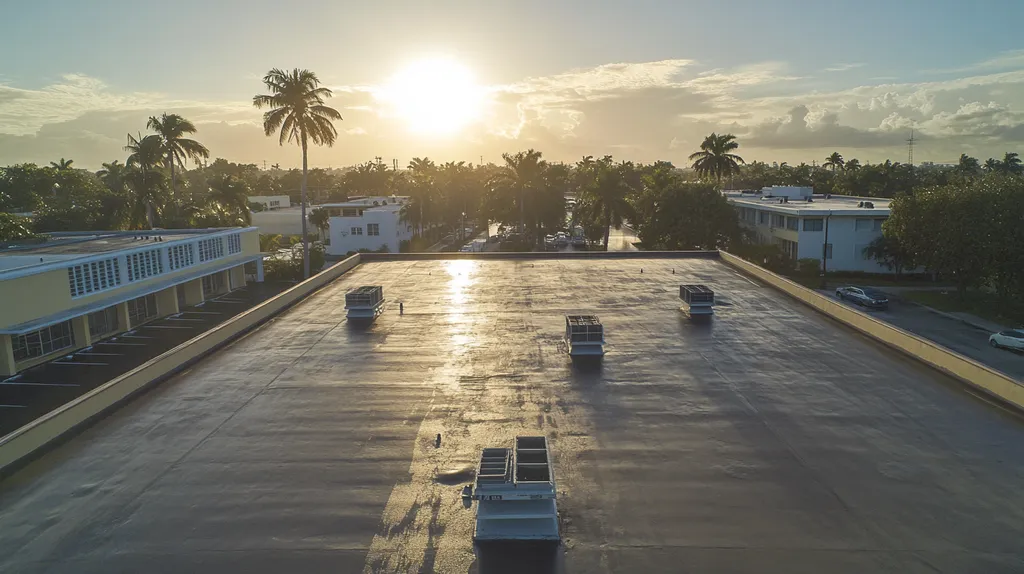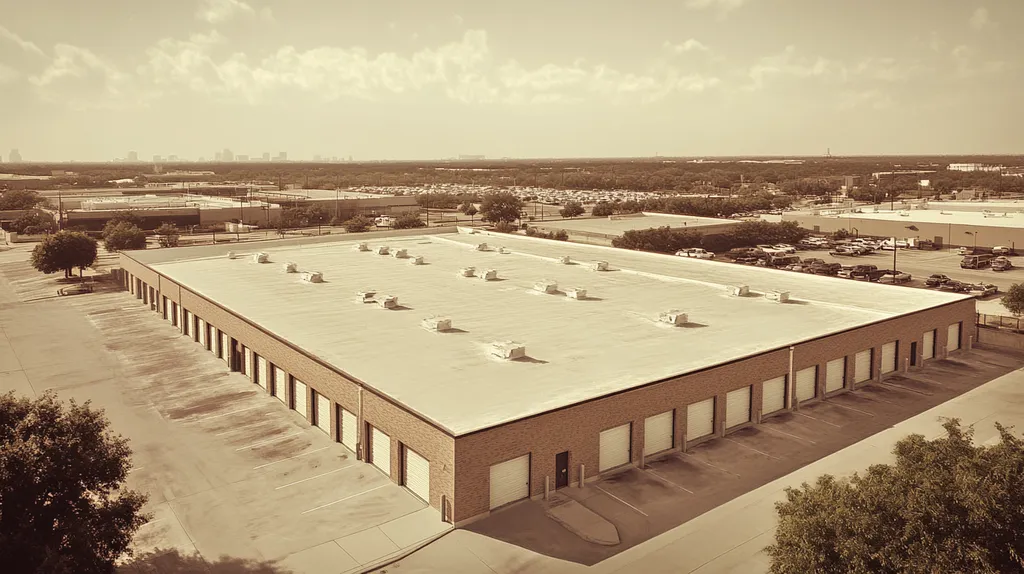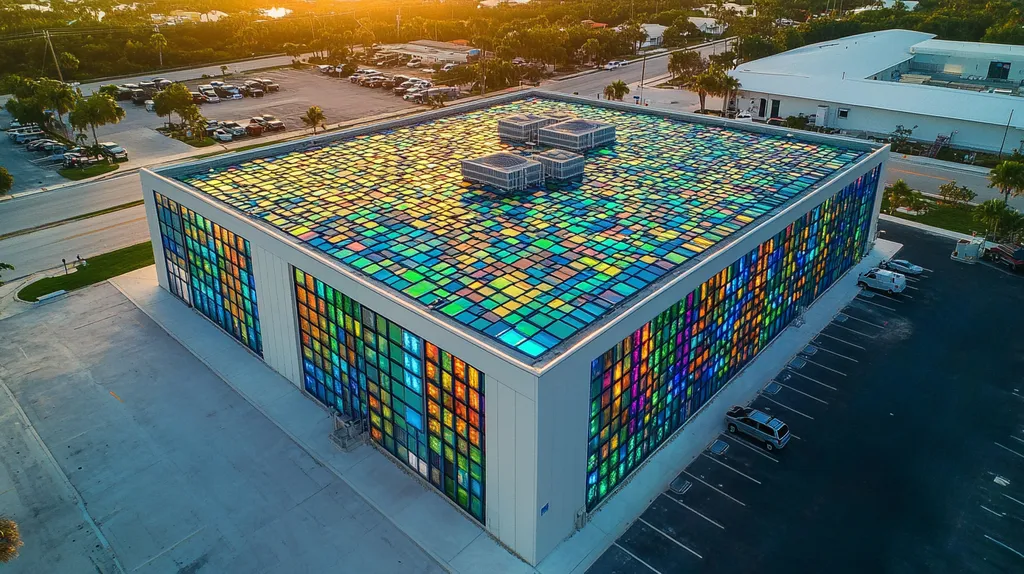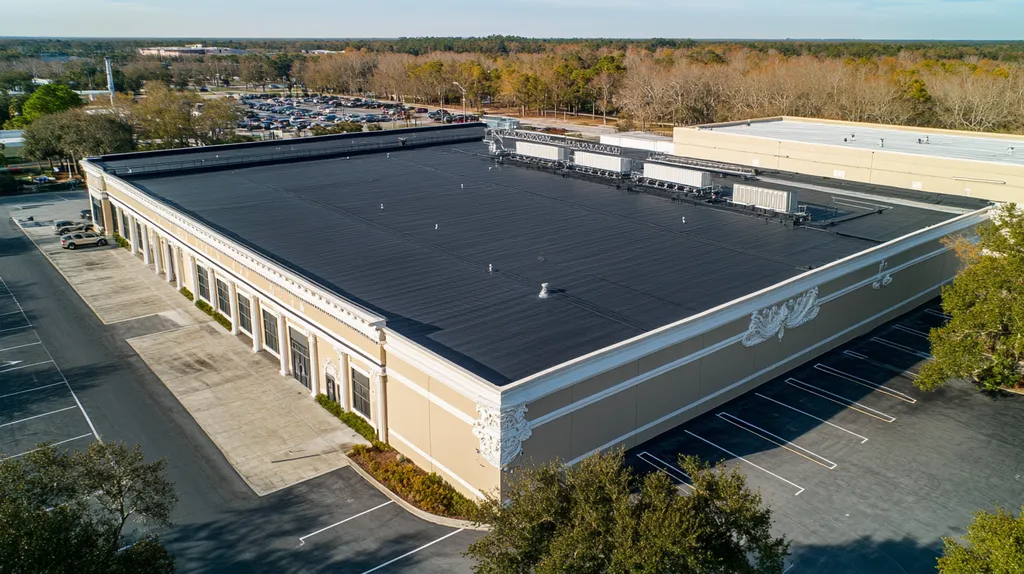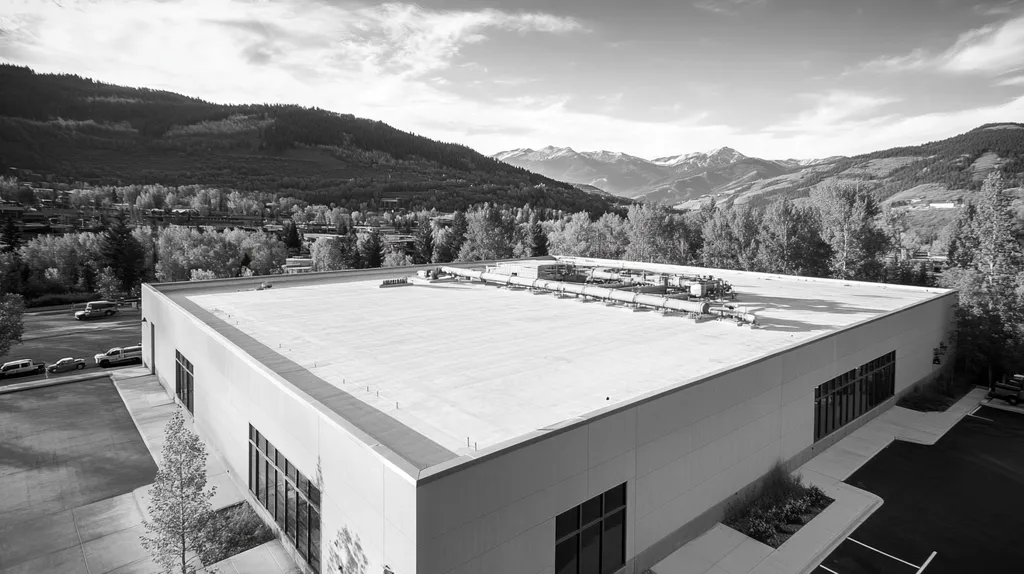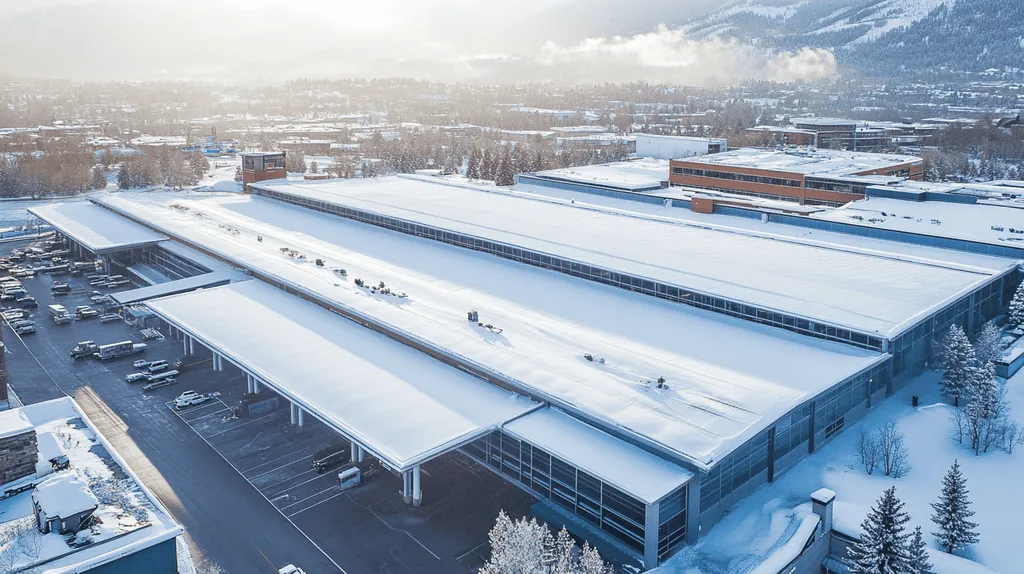Severe weather events damage over $5 billion in commercial roofing annually, with 70% of failures traced to inadequate protective coatings. As climate patterns intensify, facility managers face mounting pressure to safeguard their industrial roofs against harsh conditions.
Multi-layer coating systems have emerged as a critical defense, offering enhanced durability and weather resistance when properly implemented. However, selecting and installing the right coating solution requires careful consideration of performance factors, financial implications, and compliance requirements.
This comprehensive guide examines the essential components of effective multi-layer coating strategies, providing facility managers with actionable steps to protect their roofing investments and minimize weather-related risks.
SECTION 1: PERFORMANCE FACTORS
Protecting industrial roofs is crucial, especially in areas that experience severe weather conditions. Multi-layer coatings present a powerful defense, significantly boosting both the longevity and functionality of industrial roofs. Without sufficient protection, roofs can deteriorate rapidly, leading to expensive repairs and potential disruptions in operations. A solid understanding of the performance factors—weather resistance, wind uplift, and fire protection—enables facility managers to make informed, strategic decisions regarding their roofing systems.
Weather Resistance and Durability
Weather resistance is a fundamental concern for facility managers, particularly in environments that face extreme conditions. Multi-layer coatings form a protective barrier against rain, snow, and harmful UV radiation, which can degrade roofing materials over time. For instance, roofs that are coated with quality materials can endure harsh sunlight without suffering from fading or cracking.
Durability is equally important for long-term roofing effectiveness. Multi-layer coatings can extend the life of an industrial roof by several years compared to traditional single-layer systems. This not only reduces maintenance needs but also results in significant savings on replacement costs, ensuring a wise investment for the future.
A well-chosen coating can also markedly improve a roof’s thermal performance, aiding in temperature regulation within the building and leading to lower energy expenses. Facility managers should weigh these benefits carefully when selecting roofing options.
Additionally, conducting regular inspections of coated roofs is essential for identifying unseen damage. Engaging professionals to assess the integrity of the coating helps maintain optimal performance, especially during unpredictable weather events.
Key Action Items
Wind Uplift and Hail Impact
Wind uplift poses a significant threat to many industrial roofs, particularly in regions susceptible to storms. Multi-layer coatings enhance the adhesion and structural stability of roofs, helping them resist high wind conditions. This is especially critical for facilities situated in hurricane-prone areas where wind speeds can outstrip standard building codes.
In addition to wind resistance, multi-layer coatings improve a roof’s ability to withstand hail impact. Research indicates that roofs treated with specific coatings can endure impacts from hailstones without becoming damaged, which is vital for protecting valuable equipment and inventory underneath. This resilience is essential for maintaining business operations during severe weather episodes.
Facility managers should prioritize coatings with certified wind uplift and hail impact ratings. These ratings serve as reliable benchmarks in choosing materials that can endure the elements and last over time.
Key Action Items
Fire Protection and Class Ratings
Fire safety is an essential consideration for any industrial facility, as fires can result in dire consequences and substantial losses. Multi-layer coatings can enhance fire resistance, making compliance with safety regulations easier and offering critical protection for property. Facility managers should prioritize materials with suitable fire ratings, since this impacts not only safety but may also influence insurance coverage and liability issues.
Coatings come with varying fire ratings, categorized as Class A, B, or C, with Class A representing the highest level of fire resistance. Choosing a coating with a top rating ensures compliance with fire safety standards and reduces risks in hazardous environments.
Additionally, multi-layer coatings contribute to overall building safety by minimizing flammability and interacting positively with other structures. Facility managers should assess these interactions during the selection process.
Key Action Items
SECTION 2: FINANCIAL CONSIDERATIONS
Investing in multi-layer coatings for industrial roofs is essential, especially as climate extremes intensify. Facility owners are under growing pressure to safeguard their buildings from harsh weather, which can result in costly structural damage and repairs. A thoughtfully implemented multi-layer coating strategy can significantly reduce these risks and provide long-term financial benefits. This section will discuss initial installation costs, the savings from reduced maintenance, and the energy efficiency improvements linked to these coatings.
Initial Installation Costs
The initial investment in multi-layer coatings may seem high due to upfront costs, which can fluctuate based on the roof’s size and condition. However, the quality associated with multi-layer systems typically justifies these costs, as they offer heightened levels of protection.
Hiring a reputable contractor is vital to guarantee proper installation, thereby increasing the coatings’ longevity and limiting future complications stemming from flawed workmanship. A correct installation can prevent weather-related damages, reducing the need for emergency repairs and minimizing business interruptions.
Though budgeting for a quality multi-layer coating may exceed that of other options, it serves as a proactive barrier against future expenses. Facility managers should regard this investment as a necessary safeguard. In considering overall costs, evaluating the long-term value and durability of the roof is critical.
Key Action Items
Long-Term Maintenance Savings
One of the most persuasive arguments for investing in multi-layer coatings is their potential to achieve significant long-term savings. These systems are engineered to endure severe weather, dramatically decreasing the frequency of repairs and replacements over time.
With less wear and tear, facility managers can expect to allocate fewer resources to emergency repairs and ongoing roof maintenance. Regular inspections can help catch minor issues early, preventing them from escalating into larger, costlier problems.
Furthermore, well-maintained roofs can often result in extended warranties on materials. By opting for multi-layer coatings, owners can keep their roofs in prime condition, leading to predictable budgets and reduced operational costs.
Key Action Items
Energy Efficiency and Cost Reduction
Multi-layer coatings can markedly improve energy efficiency, leading to significant cost reductions. By reflecting sunlight and minimizing heat absorption, these coatings help maintain cooler indoor temperatures, translating directly to lower energy bills, particularly in hot climates.
Investing in energy-efficient solutions reflects a commitment to sustainability and responsible resource management. Although the initial costs for multi-layer systems may be higher, the savings in heating and cooling expenses can outweigh these expenses over time.
Moreover, energy-efficient roofs can enhance a property’s overall market value, a key factor when negotiating sales or leases. Prospective tenants and buyers often favor facilities that implement energy conservation strategies.
Facilities upgrading to energy-efficient roofing may also benefit from available utility rebates and tax incentives. Capitalizing on these opportunities can maximize long-term financial benefits, amplifying the savings associated with multi-layer coatings.
Key Action Items
SECTION 3: COMPLIANCE REQUIREMENTS
Adhering to compliance requirements is not just a legal obligation; it’s a critical aspect of safeguarding industrial facilities from liabilities and financial loss. Building codes, industry standards, and environmental regulations dictate how roofing systems must perform, particularly under severe weather conditions. Facility managers must grasp these requirements to ensure that multi-layer coatings are effective and compliant. This section highlights essential compliance areas that require careful attention.
Building Codes and Regulations
Building codes vary widely depending on the geographical location of the facility, necessitating that managers stay informed about the specific regulations affecting their roofs. These codes dictate requirements for roofing materials, installation procedures, and performance standards, particularly in areas vulnerable to severe weather events, such as hurricanes.
Failure to comply with local building codes can result in significant penalties or costly rework, potentially leading to the complete replacement of roofing systems. Facility managers should regularly consult with local building authorities and qualified roofing professionals to ensure that the materials and coatings used align with current standards.
Moreover, it is crucial to assess the structural integrity of the existing roof to support the additional weight from multi-layer coatings without compromising safety. Conducting timely inspections by certified professionals can help maintain compliance and ensure that the roofing system performs optimally during harsh weather conditions.
Key Action Items
Industry Standards and Certifications
Industry standards provide vital guidelines for material quality, performance, and testing protocols. Organizations such as ASTM International and the International Code Council regularly update these standards to incorporate advancements in roofing technology. Facility managers should ensure that the selected products meet or surpass these benchmarks for durability and effectiveness.
Certification marks, like ENERGY STAR and the Cool Roof Rating Council (CRRC), can further authenticate a product’s claims regarding energy efficiency and weather resistance. Utilizing certified products not only ensures compliance but can also lead to potential insurance savings and improved marketability of the facility.
Regularly reviewing product certifications is vital. Keeping all roofing materials up-to-date with current industry standards mitigates risks associated with substandard coatings and enhances operational reliability.
Key Action Items
Environmental and Safety Compliance
In today’s world, environmental concerns are increasingly important for facility managers. Compliance with regulations governing the environmental impact of roofing materials is essential. Using coatings that contain harmful chemicals can contribute to pollution and endanger health if not properly managed.
Regulations such as the Clean Air Act impose limits on the volatile organic compounds (VOCs) released by certain roofing materials. Opting for low-VOC coatings aligns with compliance while promoting healthier indoor air quality for occupants.
Additionally, it’s vital to adhere to safety standards during installation and routine maintenance. OSHA regulations require safe practices, ensuring that workers are equipped with the necessary safety gear and training to manage hazards associated with working at heights.
Key Action Items
SECTION 4: RISK MANAGEMENT
In the industrial roofing arena, weather-related risks are a serious concern. A single leak can trigger extensive structural damage, jeopardizing asset value and disrupting business operations. Alarmingly, nearly 80% of roof failures are attributed to inadequate weather resistance. To protect facilities, property managers must assess these risks proactively, implement robust preventive strategies, and ensure roofs can withstand challenging conditions. This section outlines essential steps for effective risk management—emphasizing weather risk evaluation, leak prevention, and liability reduction.
Assessing Weather-Related Risks
Understanding weather-related risks is crucial for effective roofing maintenance. Facility managers should routinely evaluate their facilities against local climate data, identifying possible hazards like heavy snow, intense rainfall, or extreme heat. By targeting these vulnerabilities, management can better prepare their roofing systems.
For example, roofs located in regions with high winds may suffer membrane damage, while those in areas with frequent heavy rain face risks of water pooling and leaks. A risk assessment checklist can help pinpoint and document these specific dangers.
Recognizing seasonal shifts is also vital. A comprehensive strategy should include thorough inspections after severe weather events to preemptively mitigate risks and prolong roof life. Furthermore, real-time weather monitoring systems can deliver alerts on changing conditions, allowing for timely maintenance scheduling that curtails damage.
Key Action Items
Mitigating Water Infiltration and Leaks
Water infiltration can rapidly escalate into a serious crisis. Multi-layer coatings provide a strong line of defense against leaks by significantly reducing the risk of water intrusion. A properly applied coating not only seals the roof but also enhances its longevity.
Moreover, effective drainage systems are fundamental to preventing leaks. Clogged gutters and downspouts can cause water accumulation, heightening the chance of roof failure. Facility managers should enforce routine inspections and maintenance protocols to ensure clear drainage.
Additionally, implementing tapered insulation can direct water away from vulnerable roof areas, further minimizing leak risks. Comprehensive waterproofing strategies are essential to protect valuable assets beneath the roof. A swift response plan for addressing leaks, including reliable repair contacts, is critical for maintaining business continuity.
Key Action Items
Reducing Liability with Robust Roofing
The liabilities stemming from roof failures can be substantial. When a roof leak damages property or disrupts business functions, it can threaten a company’s financial stability. By implementing robust roofing solutions, facilities can significantly minimize these risks.
Multi-layer coatings not only enhance durability but also ensure compliance with safety regulations. Roofs that meet or exceed local building codes diminish potential legal liabilities linked to insurance claims. Regular audits and documentation of maintenance and repairs further demonstrate diligence to insurance providers.
Performing routine roofing audits allows managers to detect risks before they become critical issues. With proactive measures in place, facility managers can enhance their defenses against liabilities while securing their investments.
Key Action Items
SECTION 5: OPERATIONAL PROCEDURES
Implementing effective operational procedures is essential for extending the lifespan of industrial roofs, especially those enduring severe weather. While multi-layer coatings provide substantial protection, their benefits can only be maximized through careful installation and diligent maintenance. Each operational step—from installation to urgent repairs—requires strategic planning to avoid costly damages.
Installation Best Practices
Implementing a structured approach to install multi-layer coatings is vital for optimal performance. Surface preparation stands as a critical first step; removing debris, moisture, and contaminants ensures strong adhesion, which enhances the coating’s longevity and effectiveness.
Following manufacturer guidelines for layering and application thickness is equally important. Proper amounts of coating are essential to withstand harsh climatic conditions. Technicians need to be well-trained in using the right tools and techniques for consistent application.
Weather conditions during installation significantly affect outcomes. Ensuring ideal temperatures and humidity levels during the curing process minimizes defects, allowing the coating to operate as intended under extreme weather. Additionally, providing ongoing training to staff can help maintain high installation standards and prepare them for unforeseen challenges.
Key Action Items
Regular Inspection and Maintenance
Implementing routine inspections is crucial for identifying issues before they escalate, especially after severe weather events. Establishing a consistent inspection schedule, ideally every six months, enables facility managers to evaluate the condition of multi-layer coatings and identify potential damage from UV rays, moisture, or physical wear.
During inspections, technicians should check for indicators such as peeling, cracking, or bubbling. Each of these signs indicates potential compromise in the coating’s integrity, requiring immediate attention to avert larger issues.
Maintaining cleanliness on the roof by removing debris and algae is also necessary, as these can degrade the coating over time. A straightforward cleaning can restore the protective properties of the surface. Utilizing digital tracking systems for inspections and maintenance can enhance decision-making and improve scheduling for repairs.
Key Action Items
Emergency Repair and Patching
Despite proactive measures, emergencies may occur that necessitate swift roof repairs. Creating an effective emergency response plan can streamline procedures for evaluating damage and determining necessary repairs. Timeliness is critical; delays may exacerbate damage and inflate repair costs.
Patching damaged areas swiftly is essential. Using compatible materials that match the existing multi-layer coatings ensures seamless repairs. Keeping repair kits on-site, stocked with essential materials for various scenarios, can facilitate rapid responses.
Maintaining clear communication with roofing contractors during emergencies enhances repair reliability. Quick collaboration ensures repairs are executed efficiently while preserving the roof’s integrity. Learning from previous incidents is also beneficial; identifying common threats and developing contingency plans can further reduce future risks.
Key Action Items
SECTION 5: OPERATIONAL PROCEDURES
Implementing efficient operational procedures is essential for extending the lifespan of industrial roofs, especially those facing severe weather conditions. While multi-layer coatings offer substantial protection, their full potential is realized only through careful installation and ongoing maintenance. Every operational step—from installation to emergency repairs—must be meticulously planned and executed to avoid costly damage.
Installation Best Practices
A systematic approach to installing multi-layer coatings is crucial for achieving optimal performance. The first step is thorough surface preparation; removing debris, moisture, and other contaminants is vital for ensuring strong adhesion. A clean, dry base promotes better bonding, greatly enhancing the coating’s durability.
Following manufacturer guidelines for application thickness and layer management is equally important. Applying the correct amount safeguards against environmental adversities. Moreover, technicians should be well-trained in utilizing appropriate tools and techniques for achieving consistent application.
Weather conditions during the installation process significantly impact outcomes, making it essential to maintain ideal temperatures and humidity levels for effective curing. This attention to detail minimizes defects, ensuring that the coating can withstand severe weather conditions as designed.
Finally, providing regular training for staff keeps installation standards high. Knowledgeable teams are better equipped to manage challenges that might arise, securing roofs against the impacts of extreme climates.
Key Action Items
Regular Inspection and Maintenance
Consistent inspections are vital for detecting and addressing issues before they escalate, particularly following severe weather events. Facility managers should establish a routine inspection schedule, ideally every six months, to evaluate the condition of the multi-layer coatings. This proactive approach safeguards against damage resulting from UV exposure, moisture intrusion, or physical wear.
During inspections, technicians should specifically look for signs such as peeling, cracking, or bubbling in the coating. Each of these indicators suggests a failure in integrity that requires prompt attention to prevent minor issues from evolving into significant problems.
Routine maintenance should also focus on regular cleaning of the roof surface to eliminate debris and algae build-up. These contaminants can hinder performance, leading to potential leaks. A simple cleaning can rejuvenate the roofing surface and restore its protective qualities.
Implementing a digital tracking system for inspections and maintenance records can streamline this process, enhancing decision-making and repair scheduling.
Key Action Items
Emergency Repair and Patching
Despite all preventive measures, emergencies can arise that require immediate roof repairs. Developing an effective emergency response plan is essential for outlining procedures to evaluate damage and determine necessary repairs. Timeliness is critical; delays can exacerbate existing damage and inflate repair costs.
Patching affected areas quickly is paramount. Using compatible materials that align with the existing multi-layer coatings ensures a seamless repair. Facility managers should maintain on-site repair kits stocked with essential materials to handle various scenarios.
Establishing clear communication channels with roofing contractors during emergencies enhances repair reliability. Quick collaboration ensures repairs are executed efficiently, preserving the roof’s integrity.
To reduce the likelihood of future emergencies, facility managers should analyze past incidents, identify common threats, and create contingency plans that improve preparedness and minimize risks.
Key Action Items
Looking Ahead
With severe weather events causing over $5 billion in annual commercial roofing damage, facility managers can no longer afford to delay implementing robust protective measures.
Multi-layer coating systems represent a critical defense against harsh conditions, offering enhanced durability that can extend roof life by 15-20 years when properly maintained.
The key to success lies in selecting high-performance coatings that align with local climate challenges while adhering to installation best practices and compliance requirements.
Regular inspections, proactive maintenance, and swift emergency repairs complete a comprehensive strategy that safeguards valuable assets and operations.
As weather patterns continue to intensify, investing in quality multi-layer coatings isn’t just an option – it’s an essential business decision for long-term facility protection.
FREQUENTLY ASKED QUESTIONS
Q. What are the performance factors of multi-layer coatings for industrial roofs?
A. Performance factors include weather resistance, wind uplift, and fire protection, ensuring longevity and functionality. Proper understanding of these characteristics helps facility managers make informed decisions, mitigating risks associated with harsh conditions.
Q. How do multi-layer coatings affect the financial aspects of commercial roofs?
A. While initial installation costs might be higher, these coatings lead to long-term savings. Their durability results in fewer repairs, reduced maintenance costs, and enhanced energy efficiency, ultimately benefiting your budget and operational expenses.
Q. What compliance requirements must be followed for industrial roofs?
A. Compliance involves adhering to local building codes, industry standards, and environmental regulations. Ensuring that roofing materials and methods meet these criteria helps safeguard facilities against potential liabilities while ensuring safety.
Q. How can facility managers assess weather-related risks for roofs?
A. Regular evaluations against local climate data help identify specific weather threats. Tracking patterns like high winds or heavy rainfall enables managers to implement maintenance strategies focused on their unique vulnerabilities and crucial timelines.
Q. What operational procedures are necessary for roof maintenance?
A. Establish regular inspections, thorough cleaning, and timely repairs. Creating an emergency response plan ensures swift action when issues arise, helping protect against operational disruptions and maintain roof integrity.
Q. What installation best practices should be followed for coatings?
A. Thorough surface preparation, adherence to manufacturer guidelines, and monitoring weather conditions are essential. Training technicians on proper application techniques ensures quality installation, enhancing the longevity and effectiveness of the multi-layer coatings.
Q. How can energy efficiency be improved with multi-layer coatings?
A. Multi-layer coatings reflect sunlight and reduce heat absorption, leading to cooler indoors and lower energy bills. Their implementation showcases a commitment to sustainability and may even enhance property value through energy-efficient upgrades.

